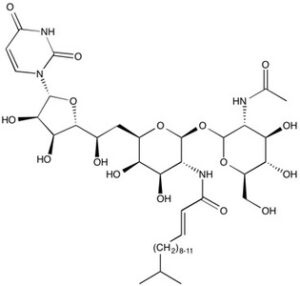Tunicamycin | ER stress inducer
NMR (Conforms)

Available Options
| Size: | Price | Quantity | |
|---|---|---|---|
| 10 mM/1 mL DMSO | $85.00 | ||
| 5 mg | $85.00 | ||
| 25 mg | $380.00 |
Tunicamycin (11089-65-9) is a fermentation product from Streptomyces lysosuperificus. Provided as a mixture of tunicamycin A (C14), B (C15), C (C16) and D (C17) homologs varying in the number of carbon atoms in the fatty acid chain. The structure shown is for tunicamycin B (the C15 homolog). Tunicamycin is a potent inhibitor of GlcNAc phosphotransferase which thereby inhibits glycoprotein biosynthesis.1 Causes endoplasmic reticulum stress-induced autophagy2 and unfolded protein response3. Tunicamycin arrests cell cycle in late G1.4
References/Citations:
1) Langan et al. (1991), Isoprenoids and astroglial cell cycling: diminished mevalonate availability and inhibition of dolichol-linked glycoprotein synthesis arrest cycling through distinct mechanisms; J. Cell Physiol., 149 284
2) Ding et al. (2007), Differential effects of endoplasmic reticulum stress-induced autophagy on cell survival; J. Biol. Chem., 282 4702
3) Jiang et al. (2007), Tunicamycin sensitizes human melanoma cells to tumor necrosis factor-related apoptosis inducing ligand-induced apoptosis by up-regulation of TRAIL-R2 via the unfolded protein response; Cancer Res., 67 5880
4) Ishii et al. (1987), Dolichol-linked glycoprotein synthesis in G1 is necessary for DNA synthesis in synchronized primary cultures of cerebral glia; J. Neurochem., 49 1606
NMR (Conforms)
Safety Data Sheet:
Product Data Sheet:
Materials provided by Focus Biomolecules are for laboratory research use only and are not intended for human or veterinary applications. Please note that we do not sell to individuals and that all orders placed by non-research organizations will incur a $20 restocking/refund fee
Tunicamycin (11089-65-9) is a fermentation product from Streptomyces lysosuperificus. Provided as a mixture of tunicamycin A (C14), B (C15), C (C16) and D (C17) homologs varying in the number of carbon atoms in the fatty acid chain. The structure shown is for tunicamycin B (the C15 homolog). Tunicamycin is a potent inhibitor of GlcNAc phosphotransferase which thereby inhibits glycoprotein biosynthesis.1 Causes endoplasmic reticulum stress-induced autophagy2 and unfolded protein response3. Tunicamycin arrests cell cycle in late G1.4
References/Citations:
1) Langan et al. (1991), Isoprenoids and astroglial cell cycling: diminished mevalonate availability and inhibition of dolichol-linked glycoprotein synthesis arrest cycling through distinct mechanisms; J. Cell Physiol., 149 284
2) Ding et al. (2007), Differential effects of endoplasmic reticulum stress-induced autophagy on cell survival; J. Biol. Chem., 282 4702
3) Jiang et al. (2007), Tunicamycin sensitizes human melanoma cells to tumor necrosis factor-related apoptosis inducing ligand-induced apoptosis by up-regulation of TRAIL-R2 via the unfolded protein response; Cancer Res., 67 5880
4) Ishii et al. (1987), Dolichol-linked glycoprotein synthesis in G1 is necessary for DNA synthesis in synchronized primary cultures of cerebral glia; J. Neurochem., 49 1606
Calculate the molar concentration, mass or volume in a solution.
Concentration × Volume × Molecular Weight = Mass
Focus Biomolecules • Plymouth Meeting, PA USA • 1-855-FOCUS21
Focus Biomolecules
Plymouth Meeting, PA USA
1-855-FOCUS21
Website Created by Advanta Advertising LLC.

